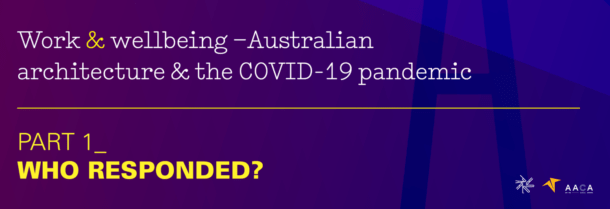This is the first of a series of posts exploring the preliminary findings of the survey Work & Wellbeing – Australian architecture & the COVID-19 pandemic. More detailed analysis and commentary will follow.

We had an amazing turnout – 2082 responses of which 1883 provided useful information. The survey was very well supported by women, who comprise 60% of respondents, which is not surprising given the Parlour community. We were also pleased to hear from the men of Australian architecture, and to start increasing our understanding of the experiences of non-binary and gender non-conforming people. There was also a strong representation of younger respondents.
These basic demographic patterns are important to consider when examining the survey responses. Subsequent analysis will disaggregate findings according to the core demographics.
A few caveats
Responses to the Work & Wellbeing survey were gathered using a ‘snowball’ method. This means that we sent out invitation to participate far and wide, and via a broad range of media. We were delighted that a very large group of people responded, which produces substantial insight into experiences and impact of the COVID-19 pandemic. This method does, however, bring limitations. It means that the results only represent the experiences of those who responded – we cannot make population wide assumptions from this data.
As a group, our respondents do not match the data on the demographic of the profession gained through the Australian Censes. Those who responded to the Work & Wellbeing survey skew towards women and younger members of the profession. This is partly a reflection of the Parlour community and the groups we have the strongest engagement with. Nonetheless and despite this caveats, the survey results provide a rich and deep resource.
The potential
The Work & Wellbeing survey collects very detailed information from a large group of people active in Australian architecture and the built environment. It provides a detailed picture of their working arrangements and conditions prior to the pandemic. It outlines experiences of the first stages of the pandemic, and provides a great deal of insight into the potential for workplace change that flows from these experiences. Lastly, the survey collects substantial material about ambitions, hopes and commitments for the profession and its possible futures.
Who responded?
Please explore the charts below. These show the basic demographics – hover your mouse over the charts to see the figures. We are working on more complex analysis – more detail coming soon.
The Work & Wellbeing survey is a collaboration between Parlour, the Architects Champions of Change Groups and the Architects Accreditation Council of Australia. It was open from 21 June–3 July 2020.
The survey was devised and developed by Justine Clark, with input and support from Gill Matthewson, Naomi Stead, Susie Ashworth, Maryam Gusheh, Brian Cooper, Julie Wolfram Cox, Monica Edwards, Chi Melhem, Thihoa Gill, Ben Green and Gemma McDonald.
Data analysis by Gill Matthewson and Anwyn Hocking. Flourish visualisations by Justine Clark.
The results will also inform the upcoming research project Architectural Work Cultures: professional identity, education and wellbeing, led by Naomi Stead and Maryam Gusheh of Monash Architecture.




















